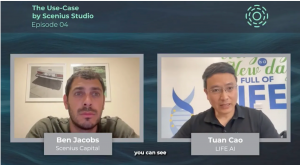LIFE AI – The Moment Web3 Turns from Hype to Healing
A human-centered DeSci platform backed by $12M transforms genetic data into secure, user-owned healthcare for 112K users across Asia.
SINGAPORE, SINGAPORE, May 12, 2025 /EINPresswire.com/ -- In a digital world obsessed with speculation and speed, one healthtech platform quietly rewrites the rules, transforming Web3 from a hype machine into a healing engineWhile much of the Web3 world has been chasing tokens, trade, and shouting decentralization from the rooftops, LIFE AI has taken a different path —less flamboyant, more human, and infinitely more profound.
That vision became LIFE AI, a Web3 genomics startup that has since grown into a community-powered movement across Asia. In a recent episode of The Use Case podcast hosted by Ben Jacobs of Scenious Studio, Life AI co-founder Dr. Tuan Cao shared the full insight of this extraordinary journey—from scientific movement to innovative platform, and from blockchain theory to real-world medical breakthroughs.
This isn’t Web3 for speculation. This is Web3 for salvation.
It’s the moment Web3 stops selling smoke and starts healing
The idea began eight years ago in a lab located in San Francisco, a compact team of leading researchers came up with a bold idea: What if you could own your DNA data entirely? And your genetic blueprint could now be encrypted, safeguarded, and utilized only with your permission.
While traditional platforms often retain and monetize your data, sometimes without explicit consent. LIFE AI flips that model entirely. Think of it as the “Android of genomics”—open, user-owned, and transparent. It’s not just about decentralization; it’s about sovereignty, security, and science that serves people.
The Turning Point
In 2017, as controversy swirled around data privacy at genetic companies like 23andMe, Dr. Cao and his team, consisting of compassionate fellows and researchers from leading institutions like UCSF, Harvard, and Cornell, saw a gap in the status quo as well as an opportunity to reshape it to their vision. Without hesitation, they relocated and built Life AI as a decentralized alternative that would give users something revolutionary: ownership.
Using blockchain-powered Gene NFTs, every user receives a secure, encrypted record of their DNA data.
LIFE AI gives users full custody over their genetic data via blockchain-powered Gene NFTs and end-to-end encryption. Every access attempt is logged transparently on-chain and secured by Trusted Execution Environments (TEEs)—ensuring no one can profit from your DNA without your consent.
“No more wondering who’s monetizing your spit,” quips co-founder Dr. Tuan Cao in his appearance on The Use Case podcast by Scenius Studio.
Real-World Impact Across Asia
To prove that Web3 infrastructure could empower real health products. LIFE AI has transformed decentralized infrastructure into real, working health products—now serving over 112,000 users across 7 Asian countries. Backed by $12 million in funding, its modular DeSci subnets are not theories—they're live deployments delivering healthcare at scale:
Kalbe Pharma (Indonesia) used Life AI to launch a stroke prevention tool in just 04 months at 10 times cheaper.
The Thai Medical Association (Thailand) integrated over 01 million health records into Life AI for precision medicine.
Hue Central Hospital (Vietnam) partnered with Life AI to conduct the region’s largest autism genetics study on 5,000 patients with only USD 10K budget.
And these are just the beginning. LIFE AI is actively collaborating with hospitals, universities, and healthtech pioneers across Asia to build a self-sovereign healthcare ecosystem grounded in genomic trust and community-powered science.
The Future is Built on Modular Blocks
LIFE AI will not stop at genetics. On the podcast, Dr. Cao unveiled their modular subnet architecture as “open-source layer for human-centered research”. This framework allows developers, researchers, and companies to build on encrypted human data in four high-impact verticals:
E-commerce: Personalized wellness products based on your genome.
AI Training: A decentralized AWS for Bio-AI development.
Drug Discovery: Faster, cheaper biopharma pipelines.
Westernized Eastern Medicine: Transforms hundreds of plant-based elements of traditional Eastern remedies into precision medicine by genomics and AI
A Community-Driven Model of Innovation
At the heart of LIFE AI is people-first philosophy. From the very beginning, the platform was built with one principle: the true value of scientific progress should return to the people who power it.
As Dr. Tuan Cao shared on The Use Case podcast, “We started as a tech company, but we quickly realized that Web3 isn’t just about infrastructure. It’s about community. We’re building a human network—one that grows stronger with every individual who contributes.”
LIFE AI’s model encourages participation from researchers, developers, and everyday users alike, creating a collaborative ecosystem where real-world health products can be built faster, smarter, and more securely. Whether validating traditional medicine or training AI models, participants become co-creators in a movement that’s reshaping healthcare
“When you give people sovereignty over their data, you also give them agency in scientific progress,” says Dr. Cao. “It becomes not just healthcare, it becomes human care.”
About LIFE AI
LIFE AI is a cutting-edge healthtech platform that combines artificial intelligence, health data, and blockchain technology to build a global self-sovereign human network. Its mission is to empower individuals to take ownership of their health data while enabling faster, smarter, and more personalized healthcare solutions.
ACP Painting, LLC Featured on Rosie On The House Podcast: A Deep Dive Into Arizona House Painting
Premium 73‑Acre Off‑Grid Luxury Barndominium Estate Listed Near Richards, Texas
Insurance School of TampaBay (ISOTB) now offers tutoring to non-ISOTB students
Kalendarium
Więcej ważnych informacji
 Jedynka Newserii
Jedynka Newserii

 Jedynka Newserii
Jedynka Newserii

Prawo

Trwają dyskusje nad kształtem unijnego budżetu na lata 2028–2034. Mogą być rozbieżności w kwestii Funduszu Spójności czy dopłat dla rolników
Trwają prace nad wieloletnimi unijnymi ramami finansowymi (WRF), które określą priorytety wydatków UE na lata 2028–2034. W maju Parlament Europejski przegłosował rezolucję w sprawie swojego stanowiska w tej sprawie. Postulaty europarlamentarzystów mają zostać uwzględnione we wniosku Komisji Europejskiej w sprawie WRF, który zostanie opublikowany w lipcu 2025 roku. Wciąż jednak nie ma zgody miedzy państwami członkowskimi, m.in. w zakresie Funduszu Spójności czy budżetu na rolnictwo.
Konsument
35 proc. gospodarstw domowych nie stać na zakup mieszkania nawet na kredyt. Pomóc może wsparcie budownictwa społecznego i uwolnienie gruntów pod zabudowę

W Polsce co roku oddaje się do użytku ok. 200 tys. mieszkań, co oznacza, że w ciągu dekady teoretycznie potrzeby mieszkaniowe społeczeństwa mogłyby zostać zaspokojone. Jednak większość lokali budują deweloperzy na sprzedaż, a 35 proc. gospodarstw domowych nie stać na zakup nawet za pomocą kredytu. Jednocześnie ta grupa zarabia za dużo, by korzystać z mieszkania socjalnego i komunalnego. Zdaniem prof. Bartłomieja Marony z UEK zmniejszeniu skali problemu zaradzić może wyłącznie większa skala budownictwa społecznego zamiast wspierania kolejnymi programami zaciągania kredytów.
Problemy społeczne
Hejt w sieci dotyka coraz więcej dzieci w wieku szkolnym. Rzadko mówią o tym dorosłym

Coraz większa grupa dzieci zaczyna korzystać z internetu już w wieku siedmiu–ośmiu lat – wynika z raportu NASK „Nastolatki 3.0”. Wtedy też stykają się po raz pierwszy z hejtem, którego jest coraz więcej w mediach społecznościowych. Według raportu NASK ponad 2/3 młodych internautów uważa, że mowa nienawiści jest największym problemem w sieci. Co więcej, dzieci rzadko mówią o takich incydentach dorosłym, dlatego tym istotniejsze są narzędzia technologiczne służące ochronie najmłodszych.
Partner serwisu
Szkolenia

Akademia Newserii
Akademia Newserii to projekt, w ramach którego najlepsi polscy dziennikarze biznesowi, giełdowi oraz lifestylowi, a także szkoleniowcy z wieloletnim doświadczeniem dzielą się swoją wiedzą nt. pracy z mediami.








.gif)

 |
| |
| |
|